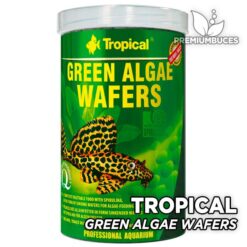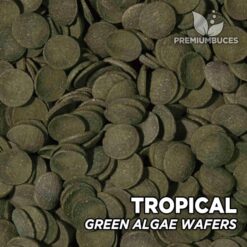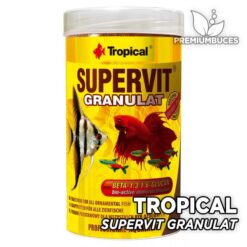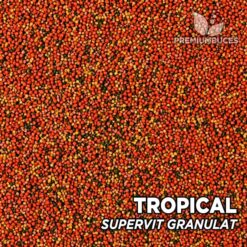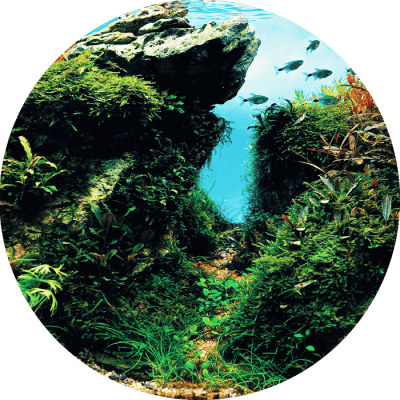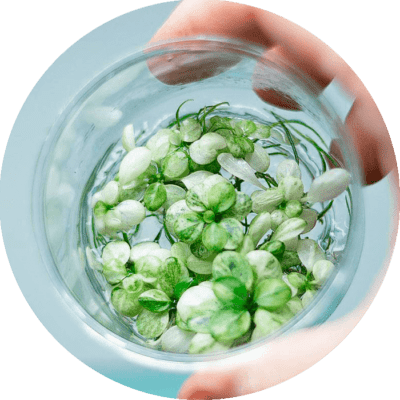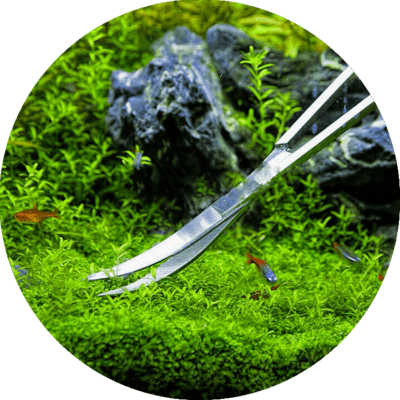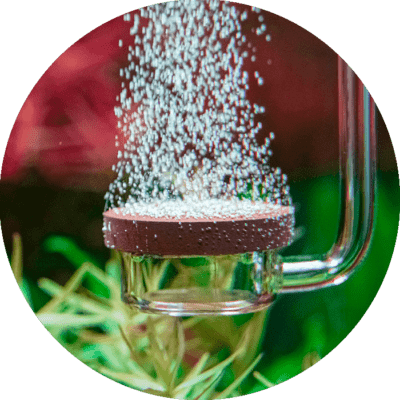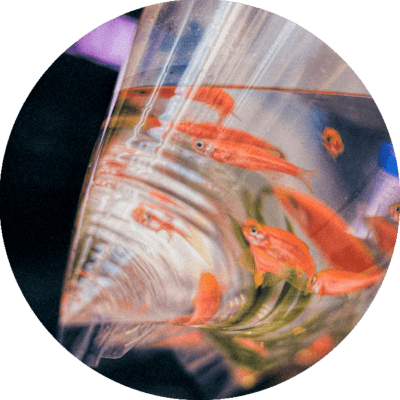Guppies are fish that belong to the Poecilia reticulata family and live in freshwater currents, but they can also adapt very well to more brackish environments. These are small fish, so they are not too used to swimming in fast or deep currents. It is very common to see them in ponds, rivers and streams.
WHAT IS THE NATURAL HABITAT OF GUPPIES?
In the wild, Guppies grow in the waters of northern South America. They can also be found on many of the Caribbean islands. In these waters they occupy the vast majority of space, but they are very capable of living outside their natural environment. Today, Guppies are a very popular species and their breeders have introduced them to other ecosystems. In the waters of North America, Europe, Asia, Africa and Australia it is very common to see them.
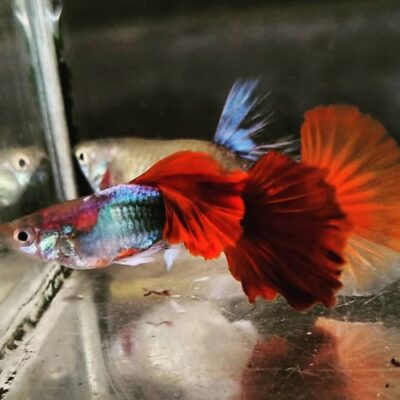
After the adaptation periods that these fish have experienced, they are able to live comfortably in the salty waters of tropical islands such as Trinidad and Tobago, Venezuela, Guyana and Brazil. However, it is necessary to bear in mind that the waters of the Caribbean where this fish lives do not have the same salinity as sea water.
The Guppy fish is a great devourer of insects and larvae. This is one of the reasons why ponds are introduced in Asian countries to control the proliferation of mosquitoes that carry malaria. Males have a very active behavior and respond well to human stimuli. It is also characterized by vibrant fur colors, although those found in the wild have a more subdued coloration to camouflage themselves from predators.
BEHAVIOR OF A GUPPY
Standardizing the behavior of guppies is not as easy as everyone thinks. Age, gender, and your environment can affect the way you interact. In general, fish are not overly expressive, but you can find characteristic traits of their character.
When feeding them you can see how a guppy behaves because it is one of the moments of greatest energy and movement. When they are newborns, they do not move as much and both males and females tend to behave in the same way. When they reach youth they become very energetic and lively. You can see them swimming in a group and they tend to create bonds of companionship, especially the males.
Like all animals, they have instincts to seek security, so they will begin to mark their territory, especially females.
Males are very curious and observant. Everything that moves in the aquarium will make you curious. When he sees his caregiver approaching, he is also able to observe and detail. On the other hand, females tend to be calmer and less curious.
When they are fry, they tend to chase each other and nibble on their fins, but over time the females grow larger, they become stronger and faster, so they lose interest in males and stop chasing them.
WHAT ARE THE WATER PARAMETERS OF A GUPPY FISH?
Guppies are easy-to-care tropical fish and a good choice for those starting to keep an aquarium. However, like all fish, they need special care to have a long and healthy life. Water is one of the most important conditions for fish. Water is the environment in which they live, feed and grow, so you have to pay special attention to the water parameters that a Guppy needs.
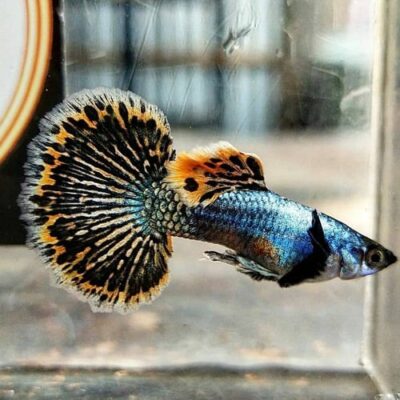
These are small fish that do not need too much water, you can also bring tankmates to reproduce them or to make a community aquarium. Guppies get along well with tank mates, And because they are small, several are worth having. In an aquarium of about 30 liters, between 4 and 5 Guppies can live comfortably.
The biological load is the waste that the fish produce, and in this case, the rainbow fish do not produce too much, so with a filtration system they can live well. However, a good filter does not exempt the weekly water changes that all fish need.
Under natural living conditions, guppies have a pH between 7 and 8. They also need clean, nitrite-free water with about 14 or 16 mg / L of oxygen. These fish adapt very well to their new environment And you can start at home with a neutral water aquarium and gradually increase the pH to more alkaline levels until you reach a good level.
Tap water usually has a pH between 6 and 7, so this can be a good option, but you have to be careful with chlorine. Although these are fish that are not overly sensitive to chlorine, the water that comes out of the tap can be harmful. Chlorine and chloramine, at low levels, are not harmful for human consumption. However, fish are exposed to water conditions all day, so these conditions can be dangerous. Too much chlorine can cause illness, weakness and death in aquarium inhabitants.
HOW MUCH DOES A GUPPY GROW?
The rainbow fish, as Guppies are also known, is small compared to most tropical and freshwater fish. Depending on the genetic condition, age and sex can vary in size, but females grow up to 3,8cmWhile males reach up to 3cm. After about six months you can see the adult tone of a Guppy.
After one month, the fry are considered to be juvenile fish. At this point the sexes can be distinguished because the female is larger than the males. After 30 days of birth, the gravid point of the females can already be seen, while the gonopod of the males is still developing.
After two months They are already in the most critical stage of their youth and are beginning to have sexual development. At this stage, breeders prefer to separate them to focus on their feeding and growth.
After 6 or 7 months, the Guppies have already left the age of youth and stop growing. Now it's easy to see the overall size of the fish, but they need an equally high-protein diet. At this point they begin to have trouble metabolizing fat, so overeating or a high-fat diet can cause breathing problems.
Between six months and a year and a half they begin the reproduction stage, but after two years, the Guppies become infertile and stop reproducing. With good care, a guppy fish can live up to three years.
AQUARIUMS FOR GUPPYS
In natural conditions, fish have a lot of space to swim, so you have to provide them with adequate space for their growth. Remember that fish are living things that you cannot have in a bowl, they need specific living conditions.
Guppies can live in small or community aquariums, but keep in mind that they reproduce very quickly, so new fish are likely to arrive. Males are very active and energetic, so they can quickly exhaust the females, a ratio of two or three females to each male is fine. It is important to include live plants to hide the fry from their mothers because they can eat them.
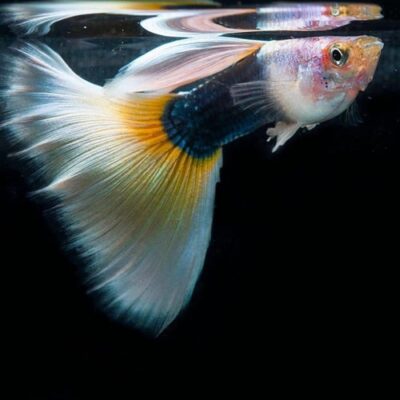
Aquariums that have multiple Guppies are really attractive. These are fish with very bright and vivid colors. From the glass you can see how these colors contrast each other.
Aquariums without a lid can be a good option for Guppies. These are fish that are not going to jump out of the aquarium, so there is no risk that they can escape and die. However, covered aquariums help gas exchange. In the water there are many agents that, if they reproduce, can be harmful to the fish, but the big problem in these aquariums is the pollutants that can enter the water.
If you are in a place with a lot of dust or pollution, the best thing is an urn with a lid that protects the guppies from all these situations. In the case of insects, you also have to be careful, especially with fingerlings because they can get hurt by them. Evaluate the environmental conditions of your aquarium to see if you need one with or without a lid.
Remember that aquariums that remain covered often need a better filtration system or more frequent water changes. There are also models with folding lids to cover an aquarium during the times that it is necessary. Especially in summer to avoid excessive evaporation of water.
FILTRATION SYSTEM
Choosing the type of filter is very important. A large part of the health of the fish and the amount of these that we can maintain will depend on this. Filters help fight bacteria and chemicals that can harm fish. Many times these microorganisms grow very quickly in the water and this is usually fatal in fish.
Guppies are fish that reproduce very quickly and a female can be pregnant very soon, so it is necessary to have a large enough aquarium and a suitable filter to keep the water of the fry clean.
It is also recommended that sponge water filters be used. These are very efficient in cleaning the water mechanically, but they do not generate very strong water currents in which the fish may not feel comfortable. When guppies are in this circumstance they tend to suffer from a lot of stress and begin to swim very fast, which can cause them exhaustion.
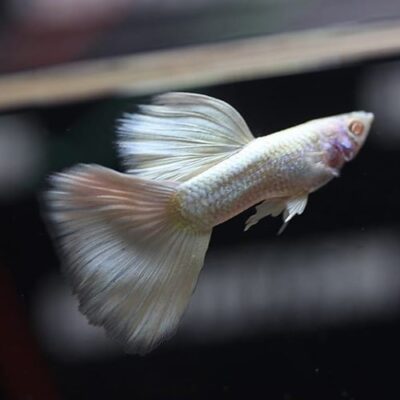
Internal filters pose a very significant problem with contaminants. Caregivers' hands can be full of many bacteria and internal filters, like all filters, need maintenance. This is a problem because any change in the filter will require the keeper to reach into the aquarium which can foul the water and disturb the fish.
Nitrates, ammonium and ammonia reproduce in water as a product of organic fish waste and plants. These usually fall to the bottom of the aquarium and begin to contaminate all the water. Bacteria also make colonies in the aquarium and multiply if there is not a good filtration system. A standard measure to know what type of filter to choose is one that has the capacity to filter between 4 and 5 times the total capacity of the aquarium.
Very powerful filters can also harm fish because they do not have a sponge to lower the water pressure. These are recommended for larger, fast-swimming fish or larger aquariums. When an internal filter is to be used, it is recommended that it be one that can be installed in the central part of the aquarium. If the aquarium is very long, and the filter does not have enough power, a certain part of the aquarium will remain stagnant, without movement and will cause anaerobic zones, which represents a big problem for Guppies. Further, planted aquariums often do not fit well with an internal filter because it takes up space for plants.
External filters are much better for guppies, plants, and water. They do not reduce the capacity of the aquarium and are more efficient than the internal ones. There are also no problems with water currents because they usually come with a regulator. It is always important to look for a filter that is quiet so as not to stress the Guppies.
Another very important advantage of external filters is that the capacity for the filter material and the hoses that draw the water have very little contact with the aquarium and there is no risk of water contamination.
AQUARIUM TEMPERATURE FOR GUPPYS
Guppies are one of the most popular fish. It is very likely that if you approach a pet store in search of your first fish, some Guppies are among the first recommendations. They are fish from tropical waters that have warm temperatures in their natural habitat. However, it is best to provide them with a temperature they feel comfortable in and not push them to the limits of their capacity.
Something very important to keep in mind with Guppies is that these are fish that have undergone genetic mutations over the years to obtain the colors they usually have. However, this has somewhat altered their resistance. That is, if they are not taken care of, the Guppies may soon get sick and die. These are easy fish to care for, but they are not the hardiest, so know how to keep them.
The average minimum water temperature of an aquarium with Guppies is 22 ° C. For a couple of days a week they can live in temperatures of up to 18 ° C, but this weakens them, and although they may not die immediately, it affects their immune system and makes them prone to disease. Fish, like all living things, need constant temperatures, and in the case of a temperature change, it must be gradual.
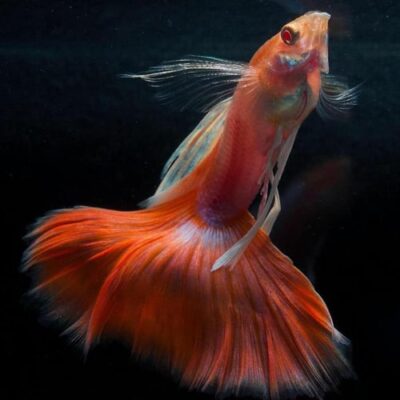
Guppy water heater
A heater is a vital accessory for Guppies. Unless you live in a place where the temperature is stable every day, you can't do without a heater. It must be taken into account that temperatures tend to drop at night and in the early mornings, and during this period of time they can suffer from cold in the aquarium. Small temperature fluctuations throughout the day can be good as long as they are mild.
Contrary to what many people think, the ambient temperature is not the same as the water temperature. Air is much more sensitive to changes in temperature than water. An aquarium will always heat up slower than water does.
Heaters are not excessively expensive, and if you buy a good quality one it will last for many years. It is impossible to maintain the temperature of a fish tank manually; air currents alter the parameters of the water and at night there is no way to measure the temperature by hand.
Many models have automatic shutoff and will stop heating based on your settings. Thermo-heaters will be very useful because very hot water also hurts fish. It is important to keep the temperature stable, not just in the range that Guppies are comfortable in. Therefore, it is not good to change from 20 ° C to 30 ° C because this will be a significant change that can cause spasms and small episodes of shock in the fish. A range of variation between 2 and 3 points of difference is fine.
Because keepers must recreate, as best as possible, the natural living conditions of fish, it is best to investigate the average temperature per year of the natural habitat of these. This is very important because it strengthens your immune system and prevents diseases.
It does not matter if it is a Guppy that has been grown in captivity, its genetics are prepared to adapt to this. It must be taken into account that the water in an aquarium cannot be drastically changed, if water other than the tap is to be incorporated, it must be gradually and in changes that do not exceed 30% of the capacity of the urn.
A thermometer is also very necessary for fish. This is the only way to know what temperature the aquarium water is at. Good quality thermometers are reliable and accurate in measuring temperature. It is recommended to measure the temperature of the end opposite to where the heater is located, This way you will be able to know precisely what temperature the water is and prevent some areas from being warmer than others.
A temperature range between 23 ° C and 27 ° C is fine for most Guppies. However, if the fish are growing, it is recommended that the water be cooler, and if they are in their adult or reproductive stages, the warmer side will benefit them.
Risks of high temperatures in fish
When fish water is too hot, their quality of life suffers greatly. The density and oxygen in the water may drop, causing your heart rate to increase and your metabolism speeding up. At the same time fish are losing the ability to pump blood and oxygen does not reach all their organs as it should.
The density of water and dissolved oxygen is altered, decreasing. It is also very possible that toxic chemicals in the water increase to dangerous levels. Fish gills are damaged because their cells increase permeability due to a change in the level of lipids.
The increase in ammonia decreases the amount of oxygen in the fish and this causes serious brain damage. They lose their ability to osmoregulate and their renal system begins to fail. Finally, photosynthesis in plants is also affected by very extreme water change.
Risks of low temperatures in fish
A very common and visible sign of low temperatures in an aquarium is lethargy in fish. They begin to swim little and stay in the low areas of the aquarium or in the middle of plants or hiding places. They also won't need to move around a lot in search of air because when temperatures drop there is more oxygen in the water.
The metabolism of the fish begins to be more slow when the water is colder, so they stop moving and eat because they do not need as many nutrients as their body requires when they have an active life.
Although the temperature of the water is very important, remember that you must take into account other indicators such as the levels of ammonia, pH, nitrites and nitrates. These factors, coupled with temperature, are half the work you need to do to keep your fish happy and healthy. If together with this, you feed them properly and make weekly water changes, you do not have to fear diseases or bacteria in your fish.
PLANTS FOR AN AQUARIUM WITH GUPPYS
Plants are a very important element for aquariums. The aesthetic aspect is the most obvious; They fill the aquarium, give it dimension and add liveliness with their colors. However, we are not going to focus on this aspect, but we will talk about the contributions to aquarium health that plants make.
Aquarium plants are very important because, among other advantages, is the leveling of the pH level and that they do through photosynthesis. In addition, they help the oxygenation of the aquarium water.
Another fundamental aspect is the assimilation of toxic agents. As we know, all the microorganisms that are in an aquarium multiply me and can reach dangerous levels. Ammonia and other nitrogenous compounds can be lethal. The decomposition of excrement, the remains of plant materials, excess compost and other agents, fall to the bottom of the aquarium and are dangerous. For its part, plants have a great capacity to assimilate these compounds and reduce the load found in the water.
Certain heavy metals, when concentrated, are harmful to health and plants are capable of assimilating them to avoid these risks. They also absorb nutrients, which will otherwise serve as food for the algae. This is important so that they do not reproduce uncontrollably and do not contaminate the water ecosystem.
In the case of spawning, this is a great place to keep the fry eggs until they hatch. They also provide shelter and create territorial barriers for fish.
In conclusion, the aesthetic aspect is not the only function of plants. Planting an aquarium is very important to provide healthy conditions for the fish and help them in their development.
Some recommended plants for an aquarium with Guppys can be:
Java ferns
This is one of the most common plants in aquariums. They are very resistant and adapt well to various temperatures. Its rhizome is thick and produces light green leaves and other dark green ones. The rhizome grows horizontally and takes root in gravel, rocks or logs and from there new leaves grow. Its leaves can measure up to 23cm, but the water of the Guppies allows them to grow only about 10 cm. This plant comes from India, South China, the Philippines and Malaysia.
Something very characteristic of the Java Ferns is that they can live with a lot of light or with little, just as they can adapt to acidic or alkaline waters, as long as extremes and sudden changes are avoided.
Cryptocoryne
These are plants that are commonly known as cryptos. They are native to the tropical regions of Asia and are a very good choice for Guppies because they do not survive in temperatures below 21 ° C.
Some cryptocorynes they are amphibian plants, while others are fully aquatic and grow well under water. Cryptocoryne Beckettii and Cryptocoryne Willisii species are often grown in aquatic plant nurseries.
These are small plants and their leaves do not usually exceed 15 cm in length. However, the rest are very easy to care for and it is capable of growing almost anywhere. The light can be dim or intense, so it can be well adapted to the lighting needs of Guppies.
The water temperature should not drop below 21 ° C because it affects them a lot. Its reproduction is easy thanks to its creeping rhizomes.
Aponogeton
If you want to make sure you feed your Guppies the best, an Aponogeton can be a great option. The tuber of these plants is quite thick and houses a large amount of nutrients for the water. In addition, this means that it can be kept well when the water conditions are not necessary.
However, the resistance of this plant cannot be abused. As soon as your tuber begins to rot, it is almost impossible to regain its health condition. With a healthy aquarium and with the conditions that Guppies need, this plant lives without much care. Also, as long as there are enough nutrients, the tuber can be kept supplied without rotting.
A common Aponogeton such as Undulatus and Natans have fairly long, wavy-shaped leaves. It can be planted almost anywhere in the aquarium and they have no growth problems. The average temperature in which it can live is between 20 ° C and 30 ° C. However, they can live in temperatures that drop to 16 ° C, but under these conditions their leaves weaken and begin to fall. Very low temperatures can also cause an Aponogeton to go into a state of inertia and inactivity. When the new leaves begin to foliate, the water must be above 20 ° C.
Echinodorus
These plants are almost exclusive to Brazil, but in other regions of South America they can also be found. Its planting is very easy and it has very large and brightly colored leaves. The shape of its leaves is very elongated, like a spear, and they resemble crypts, but thicker.
Its leaves are also quite thin, but more resistant thanks to the vein that runs through them. All the Echinodorus They grow up to 30 cm long and can live well in low temperatures. They can even flourish above 18 ° C. The lighting needed by sword plants is strong and overhead, but it can be adapted well to the needs of Guppies. They have become an aquarium favorite because they end up being the focal point of an entire aquarium. The Amazon Sword Plants bear a strong resemblance to the Echonodorus Osiris, with the exception that they do not have a very large rhizome.
These plants are found in the wild in the southern part of the United States, so it is exposed to hot climates, very similar to the natural ecosystems of Guppies. It does not have major growth problems in a normal aquarium, but because it has a small pattern, it should not be planted until the aquarium has aged after a few months.
Sagittaria
Commonly, these plants are known by the name Sag and it is easy to find them like that in nurseries. They are native to tropical and temperate zones. One of those that has become more famous in the world of home aquarium keepers is the Sagittaria Subulata.
These plants have leaves with a very elongated shape, as if it were a blade. The length usually reaches up to 7.5 cm. Because they grow rapidly when exposed to strong light, it becomes a kind of plant mat that decorates the entire foreground of the aquarium.
This is a great option for those starting an aquarium. They adapt very well to their new environments. All plants have the ability to store nutrients for certain seasons. For their part, the Sagittarios have much more bearing capacity than the Vallisnerias or Elgittario.
The Sagittaria Graminea is another that stands out in aquariums. One of its main attractions is that its leaves are a little wider and stronger. It is also longer because its blade can be up to 31 cm long. It grows very well in various types of water, but reaches its maximum splendor in good sanitary conditions.
AQUARIUM LIGHTING
Guppies are fish that grow in tropical places where they have good exposure to light. However, it must be borne in mind that fish should not be exposed to excessive sun because this can raise the water temperature too much and cause excess algae and diseases.
It is best to imitate, as best as possible, the natural living conditions of fish. Fish genetics have been developed to live under certain conditions, but these living conditions can be mimicked in domestic life. Exposure in windows, drafty or very dark places is never suitable for fish. In general, natural light in environments fluctuates during the day, which is why lamps are the best option.
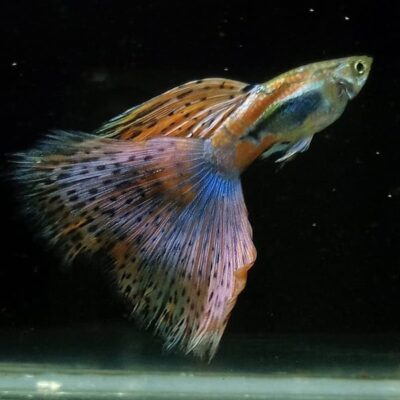
There are many options of displays for aquariums, the LED screens they are the most recommended for guppies. These reproduce well the changes of day and night. This is important because fish are sensitive to changes in light and although their eyes remain open at night, they also need to rest.
As standard measures, 9 hours of light and 15 of darkness are usually provided, but it is best to find out about the number of hours of sunshine per day that these fish receive in their natural habitat. In this way you can recreate the cycle of daylight as it is received by fish in nature. Most of the lamps are easy to use and compatible with conventional ballot box sizes.
Guppies have the ability to absorb artificial light as if it were the natural sunlight that they have in their natural habitat. One way to make the aquarium healthier and more fish-friendly is to incorporate live plants to add more oxygen to the water. The UV light from the lamps can be set to minimum levels so as not to affect plants that can only receive a small amount of light per day.
Manually controlling an aquarium light is not a realistic option for most caregivers. For a few days this can work, but at any moment you can forget about leaving the aquarium light on for too long. This ends up affecting the fish, plants and all the inhabitants of the aquarium.
Timers are a must for an aquarium with Guppies. These turn off and on automatically according to configurations. This is the best way to recreate sunrise and sunset every day, regardless of whether the caregiver is home or not. With some LED screens we can configure the light time with its dimmer.
Guppies do not have too many demands regarding the type of light they receive, as long as it is constant and in the amount and intensity they need, they will remain healthy and happy. These fish do not have the best vision of all, so they need an amount of light that guarantees good eyesight. Fluorescent lamps and LEDs may be the best options because they are quite bright and do not consume much electrical power.
FEEDING GUPPYS FISHES
Guppies seem hungrier than they really are. Maybe when you approach to feed them they will swim energetically. But you don't have to get carried away by this; they are very likely to suffer health problems if they overeat.
Overfeeding causes them constipation and greatly affects their quality of life because the remains of food go to the bottom of the tank and begin to decompose.
A feeding of 1 or 2 doses a day is more than enough for Guppies. The variety and quality of the nutrients is the most important and they usually take about 20 or 40 seconds to eat, after this time, what you offer will fall to the bottom and begin to dirty the aquarium. Rationing portions is the best you can do so as not to give them too much food.
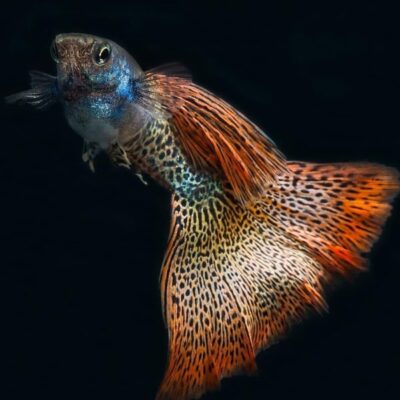
When they are offered live food, it is best to feed them slowly so that they have a chance to eat everything you give them and nothing ends up in the water. The bloodworms, shrimp or larvae are their favorites. Guppies are omnivores, so they have a good appetite and will eat almost everything you feed them without a problem, and when it comes to commercial or frozen food, there are many options available that are very nutritious for both fingerlings and adult fish. .
Ready meals are a great option when it comes to feeding fish. It is fast, practical and very nutritious, you just have to choose the nutrients and vary the meals so that your guppy is happy every time you feed him.
Scales Flake-based foods are a staple for Gupppys nutrition. These foods have the daily doses of vitamins and minerals that your fish need For their develpment. If you feed them once a day with good quality flakes with a high protein content, your fish will grow strong and with a good immune system.
The flakes can contain various types of vitamins and minerals. Read the label, the order and the quantity of the ingredients to know which of all the flake preparations will help your Guppy the most. You should also check the expiration date and the amount of flakes because once this date has passed, various nutrients and vitamins begin to be lost.
Guppy breeders usually feed them exclusively with scales and they grow very healthy, strong and with very bright colors.
Vegetable tablet
Just as children are encouraged to eat vegetables for all the nutrients and amino acids they contain, fish also need a serving of vegetables. Vegetable tablets are usually high in algae, plankton and spirulina. These ingredients have high concentrations of vitamins B, C, D, and E.
The water chain where Guppies grow, both in wildlife and domestic life, is often low in iron and calcium. Vegetable popsicles help a lot to start nourishing them and to reach the daily dose necessary for all guppies.
When you feed your fish this dose of spirulina, you help develop and strengthen their immune system to fight skin infections. Their fins are also strengthened and they have greater comfort when swimming. Lastly, spirulina helps develop Guppies' skin colors by increasing natural carotenoids.
Protein and fat
These fish also need food that provides protein in their daily diet. the shrimp in brine are his favorites. They are a great option for feeding adults and fingerlings once or twice a week. For its part, fats are very important for the development of guppies. They help to improve their reflexes, have a more agile swim and strengthen their growth.. The amount of fat that guppies receive should be controlled and not exceeded. You can always give small amounts and then increase the portion.
Conditioners are also an item that guppies will greatly appreciate. Tubifex worms must not be alive because there is a risk of carrying bacteria. On their way home they can harbor infections that are capable of killing fish. Freeze-dried tubifex worms can be a good option a week for your guppies.
GUPPYS DISEASES
Any fan of the aquarium world knows Guppy fish, but the species found in stores are not usually the most resistant. This is due to the success they have had as an ornamental species. Selective breeding has created a genetic cross between individuals with close kinship ties, which has brought less resistance and weakness of the immune system, as well as malformations.
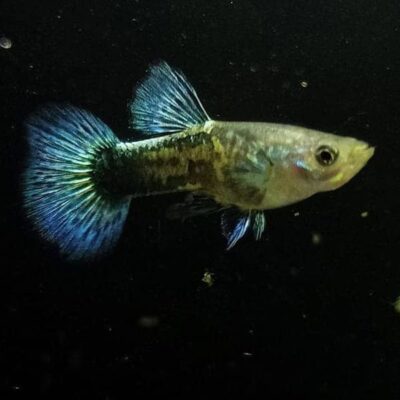
Although there are diseases and health problems that we do not mention in this article, we will talk about the most common and those with the most visible symptoms for the caregiver. It is important to make it clear that most of the diseases that a Guppy can suffer are those that are related to poor aquarium conditions when the fish are in captivity. If you keep your Guppies on the food and aquarium characteristics they need, they shouldn't have major health problems.
Infectious diseases
This type of health problem is associated with the physicochemical conditions of the water. There can also be cases in which a Guppy suffers from these common diseases due to its weakened defense systems from birth.
Tuberculosis
This is a disease that does not occur very often in home aquariums. However, when they appear, it is usually the Guppies who suffer from tuberculosis. This type of tuberculosis is not the same as that which affects humans, so you should not worry.
Bacteria of the genus Mycobacteria are those that cause tuberculosis in fish. A big problem with this disease is that its symptoms are very ambiguous and are not so easy for the caregiver to detect. A more common problem associated with tuberculosis is the delay in diagnosis. Because of the time it takes for the infection to progress through the fish's body undetected, treatments are often not successful.
Some of the symptoms that can be found are discoloration in your skin, lack of appetite or even starvation, retracted fins, eyes with bulges or inflammation, the belly can also present inflammation and discoloration.
The most common route of transmission of this disease is direct contact between fish. Contagion can also occur through water, and lastly and less frequently, it is the transmission of tuberculosis by embryos while they are still inside the mother's body.
Septicemia
This is a group of internal diseases of bacterial and / or viral origin. It produces severe fluid retention, so the first visible symptom is a widening of the abdomen. These diseases are also known as dropsy or ascites.
This disease can also be detected by the increase in the ventral area. This is caused by the rising of the scales and the inflammation of the abdomen. Exophthalmia, hemorrhages and other pathologies at the base of the fins or around the eyes can also be secondary conditions derived from these conditions.
Antibacterials and antibiotics are the main treatments for these diseases. Concentrates such as chloromycetin from 10 to 20 mg / l of aquarium water in which the treatment is carried out are usually used.
Freshwater white point
One of the main diseases that occur in Guppies is the freshwater white spot. This is not a unique complication of Guppies, and not even fish, it is very common to see it in viviparous ones. This infection is caused by the protozoan parasite Ichthyophthirius multifiliis.
Whiteheads on the skin or in the eyes are the most prominent symptom. They also appear very frequently on the gills.
Treatments for freshwater whitehead are many and varied. Prophylaxis is one of the most common because it increases the temperature between 30 ° C and 32 ° C, which reduces the reproduction of the parasite.
Poison
Guppies are not as prone to infections due to the toxic agents that live in the water and decrease the probability of growth of infectious pathologies. However, Guppies are the domestic species that presents the most data and infections due to infections.
For example, the presence of nicotine at as low as 10mg / can kill small fish in 5 minutes. An overgrowth of infections can also occur from a diet high in commercial and dried foods. Constant infections can seriously weaken the metabolism of fish when they are constantly exposed to these living conditions.
Fatty degeneration of the liver
A diet based on foods high in lipids can cause this disease. When carbohydrates are in high concentrations, it can also be indicative of other liver problems in fish.
When there are not enough amounts of fatty acids and vitamins, fat accumulates in the liver, which can cause the liver to stop working and the fish to die.
Obesity is one of the most notorious symptoms of fatty liver. This can reach disproportionate levels affecting the anatomy of the fish. Swelling and exophthalmia usually occur in the ventral area.
Treatments for a fatty liver in Guppies consist of a change in eating habits. Lower the levels of consumption of lipids and carbohydrates. Tubifex worms have a high concentration of fat, so its consumption should be reduced.
Health problems associated with water quality
Staying in slightly acidic waters can bring certain health problems for Guppies. Aquarium mates or the oxidation of organic matter at the bottom of the aquarium may cause a drop in the pH level, causing listless behavior and discoloration of the Guppies' skin color.
When the water becomes too acidic for these fish, hyper-segregation of the mucous membranes and spasmodic swimming can occur. At this point a water change is necessary to alkalize the pH to healthy levels for the Guppies. It is important that this change is gradual because fish do not usually respond well to a very drastic change in the water.
Carbon salts can be used to harden the carbonates that support the pH.
When it comes to poor maintenance, the filter should be checked and the water changed to restore conditions as soon as possible.
Deformations
The curvature of the spine is one of the most common anatomical defects of Guppies. The origin can be very varied. It can be tuberculosis or it can also be anatomical physiological birth defects.
In the case of males, their large fins can curve the vertebrae of the columns. In the case of females, consecutive deliveries can cause damage to their spine. The problem with these deformations is that they have no solution, so you should choose proportional fish and allow a resting time between the calving of the females.
FISH COMPATIBLE WITH GUPPYS
Guppies are very peaceful and have no major behavior problems. The most suitable option as companions are small fish so that there are no conflicts in the aquarium. Note that large fish can develop a territorial instinct And they might want to eat your Guppies.
Avoid fish that are not peaceful or very aggressive. There are also fish that enjoy nibbling the fins of their tankmates, this is also dangerous to keep an aquarium with Guppies. Water conditions such as pH and temperature must be the same for all fish. We show you the best Guppy compatible fish:
mollies
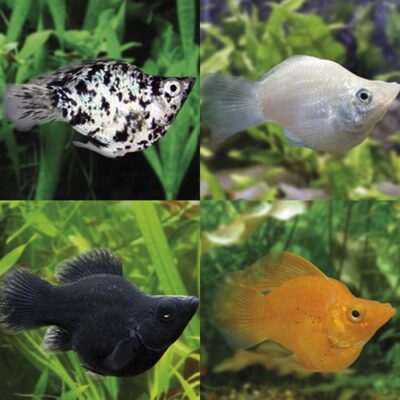
This is a Guppy's first mate candidate. Both are cyclical and their behaviors and habits are quite similar. Despite the fact that they grow a bit larger than Guppies, there is no risk of being eaten. They can attack the fry, but the Guppies themselves can also eat their young.
They reproduce easily and have very vibrant colors. They do not present major problems in their care. They have a life expectancy of between 2 and 3 years and must be kept in aquariums of at least 100 liters. Like male Guppies, male Mollys need a ratio of 3 females to each male.
Platy's
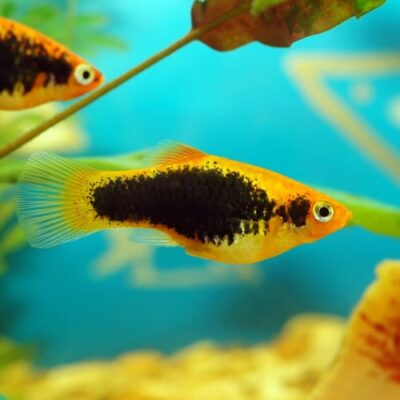
Like Mollys and Guppies, Platys are cyclical and can live perfectly with these fish. Although they really like to chase their companions, you don't have to worry about injuries because they won't hurt the Guppies.
The colors are varied and do not present a problem in your daily care. They are resistant to disease and reproduce easily. Males grow to about 5cm, while the females are larger they grow up to 7cm.
They can live up to 3 years and need an aquarium of about 70 liters. Remember that whenever you add an aquarium companion, it is necessary to have the capacity to receive it. They need about 3 females for each male and live in waters with a pH between 7 and 8. The average temperature for them is 24 ° C and 28 ° C
Corydoras

This is a species that is really compatible with many aquarium fish. They are friendly and peaceful like Guppies and often swim to the bottom of the aquarium. They usually stick together and swim in groups of 6 or more.
They are not as colorful as the previous fish, but their main attraction is that they always swim together and at the same rate. Corydoras aeneus are the best fit to adapt to the water conditions of a Guppy.
They are often called "pool cleaner" fish and are very useful when it comes to keeping the substrate clean. They usually eat surplus food at the bottom of the aquarium so that it does not start to decompose.
These are quite long-lived and can live up to 10 years and grow up to 7cm. It is necessary to keep them in an aquarium of about 60 liters. If you want to make additions to corydoras and guppies, these fish and they enjoy vegetation a lot. Ideally, provide fine-grained and smooth substrates. You have to avoid the edges of any other similar material because they can hurt your beards.
They need a pH of 6 to 7.5 and the average temperature for them is between 26 ° C, but they resist well in aquariums of 22 ° C.
Zebritas
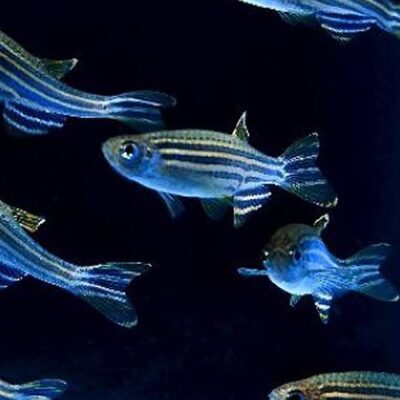
Zebras are related to barbels, better known as fin bites, but they can live well with Guppies because they do not have these aggressive tendencies.
They swim very fast and are energetic. They are usually kept in groups and are quite peaceful. They have color patterns between black and white, similar to the zebras we all know. It was the first vertebrate capable of being cloned and they are easy to reproduce.
At a pH between 6 and 7 they will feel comfortable. The water temperature can vary between 24 ° C and 28 ° C. They need an urn with a capacity of 60 liters or more because they tend to swim quickly and are very active.
danio pearl

The Danio Perla is quite similar to zebra in their behavior and temperament. They have a more striking coloration that goes between silver tones with purple, blue or green flashes. They should also be kept in groups of 6 or more.
They grow up to 6cm and can live in water with a pH between 6.5 and 8. The temperature is equal to what Guppies need and they can live well when exposed to light, so the aquarium lights will not disturb them. These have a slightly higher life expectancy than zebrafish and live up to 5 years.
Guppies are very good inhabitants of a beginner aquarium. They do not need excessive care and are quite active. After their selective breeding they have developed very interesting colorations on their skin. If you are wondering about any aquarium fish to start with, Guppies are an excellent option, and not only for their care, but for their temperament. Other fish are also easy to care for, but they end up devouring their mates or are too territorial or aggressive. After reading all about the guppy care, it's time to add them to your aquarium.
Other articles of interest may be:
How to Eliminate Aquarium Algae - Causes and Most Effective Treatments
Caridines and Neocaridines - File and Care Aquarium Prawns
Rate this article:
In our online store you can buy Food and Accessories for Guppy fish and receive them in 24 hours in Spain.







